Pre-Columbian Art History Final Exam
1/120
There's no tags or description
Looks like no tags are added yet.
Name | Mastery | Learn | Test | Matching | Spaced |
|---|
No study sessions yet.
121 Terms
Popol Vuh
Means the Book of the People. It is an Epic or Poem. There are 3 volumes - I is about the creation of the world, II is about the Hero Twins, III is about the migration of the Qiche/Quiché Mayan People
chiasmus/merismus
Chiasmus is a figure of speech in which the grammar of one phrase is inverted in the following phrase, such that two key concepts from the original phrase reappear in the second phrase in inverted order. The sentence "She has all my love; my heart belongs to her," is an example of chiasmus.
Merism is a rhetorical device (or figure of speech) in which a combination of two contrasting parts of the whole refer to the whole. “For better, for worse”
Xibalba
The “place of fright,” the underworld ruled by Maya death gods.
Quiché
a Mayan dialect
Huracan
the Heart of Sky - one of the main characters in the Popol Vuh. One of the creator deities who participated in all 3 attempts to create humanity
Hunahpu and Xbalanque
the Hero Twins. They avenged their father’s defeat by outsmarting the underworld lords.
Xmucane and Xpiyacoc
the divine grandparents of Hunahpu and Xbalanque. Had a role in the creation myth, they ground the maize that was used during the third attempt to create humanity.
Seven Macaw
A bird demon defeated by the hero twins when they tricked him and took his face jewelry. He pretended to be the sun and the moon of the twilight world.
Palace, Palenque (Late Classic) [including talud panels depicting captives and the Palace Tablet depicting K’an Hok’ Chitam II]
The ruler lived in the palace, right next to the Pyramid. The palace is a complicated structure. Room E, the throne room, is in the center, furthest from the outside so one needs to walk through the grandeur of the palace in order to arrive at the throne room. on their way, they will pass by the talud panels depicting captives - intimidating!

Temple of the Inscriptions, Palenque (Late Classic)
9 levels. Dedicated to Pacal and only Pacal. 13 levels in the tomb, perhaps corresponding to the sky realm. A massive sarcophagus lid shows the image of pacal, presenting him almost as a sacrificial figure.

Pakal entering the underworld (sarcophagus lid), Temple of the Inscriptions, Palenque
Note bicephalic dragon or dragon with two heads in the cruciform world tree just above Pakal.

Structure 33 (dedicated to Bird Jaguar), Yaxchilan (Late Classic)
Very expanisve. Perhaps astronomical markers. Large roof comb.
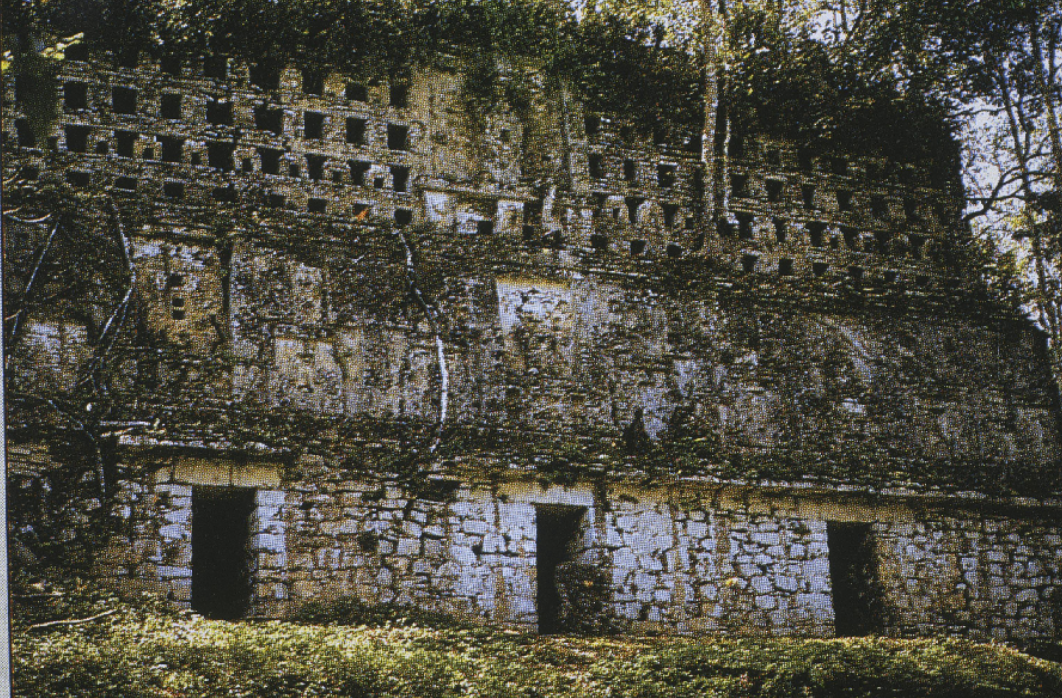
Monster mouth, Chicanna (Late Classic)
Walking through the doorway, one would feel as though they were walking through a monster mouth
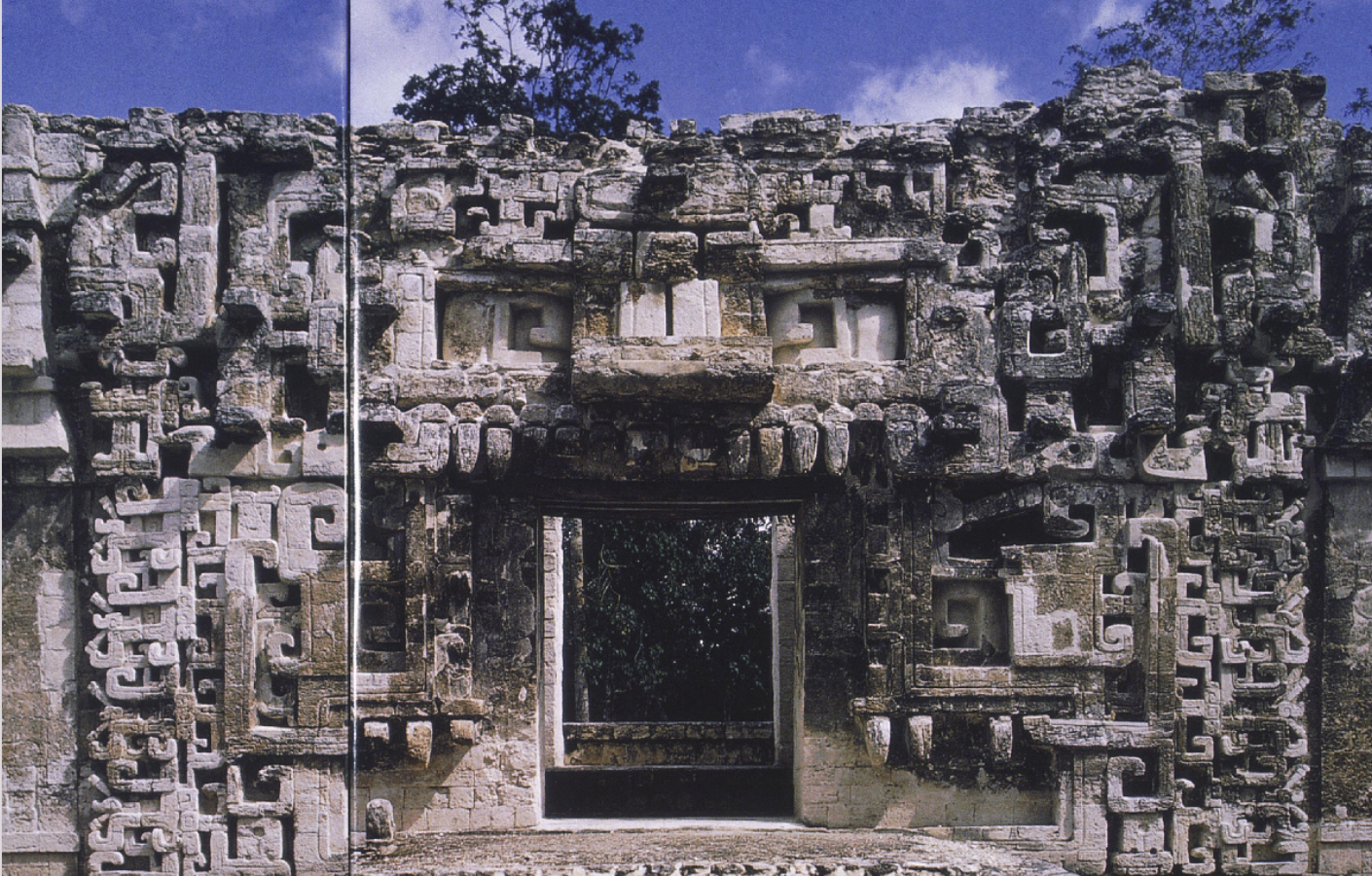
House of the Governor, Uxmal (Late Classic)
Very wide. 11 doorways. Center, left, and right continuously emphasized. Complex masonry mosaic (small boxes create a pattern of a medium box, which creates the pattern of a large box)

Lintel 25 (Lady Xoc receiving a vision), Yaxchilan (Late Classic)
Lady Xoc, wife of Shield Jaguar, invoking a royal ancestor. Some glyphs are larger to indicate closeness to the viewer/further away.

Stela 11 (Bird Jaguar), Yaxchilan (Late Classic)
depicts bird jaguar and his father, bird jaguar with captives. glyphs as architecture (almost a corbelled vault)

Zoomorph P, Quirigua (Late Classic)
carved into a river boulder, late classic variation on Altar 4 at La Venta, entire boulder is a monster mouth meaning the figure would be seated within the mouth
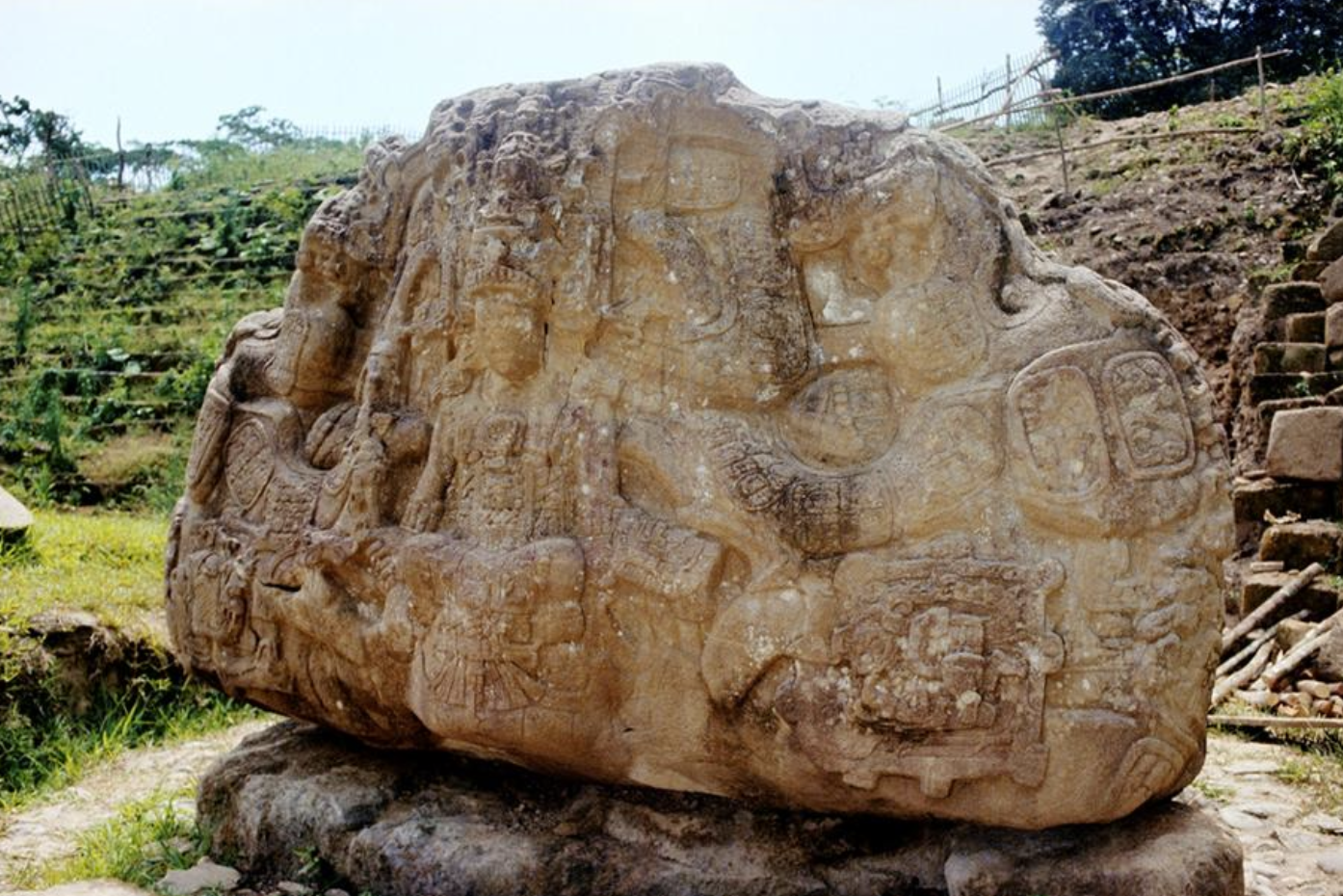
Altar Q (Yax K’uk Mo’ and Yax Pasaw), Copan (Late Classic)
almost looks like a raised platform or table. located in front of pyramid, glyphic inscription on top. rulers of the late classic dynasty on the sides, starting with founder yax-kuk-mo. 16 rulers total. appears that yax-kuk-mo is giving the bisophalic rod to the most recent ruler, yax-pac. seated in a circle meaning everything around them is within the circle because they face outward - we are within their circle.
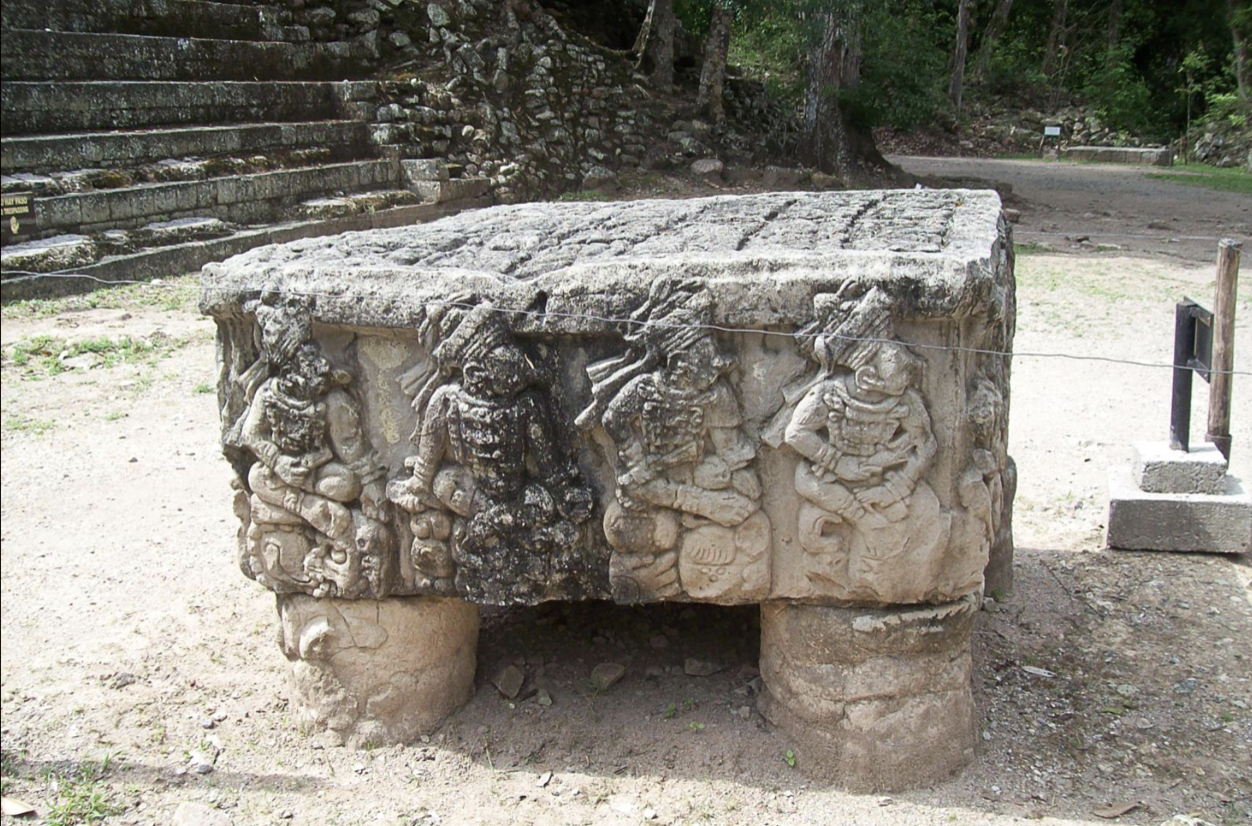
Sacrifice scene with Chaak and Death God, codex-style vessel (Late Classic)
figure on the snake altar (same pose as pacal), a sacrificial figure, chaak, and death god
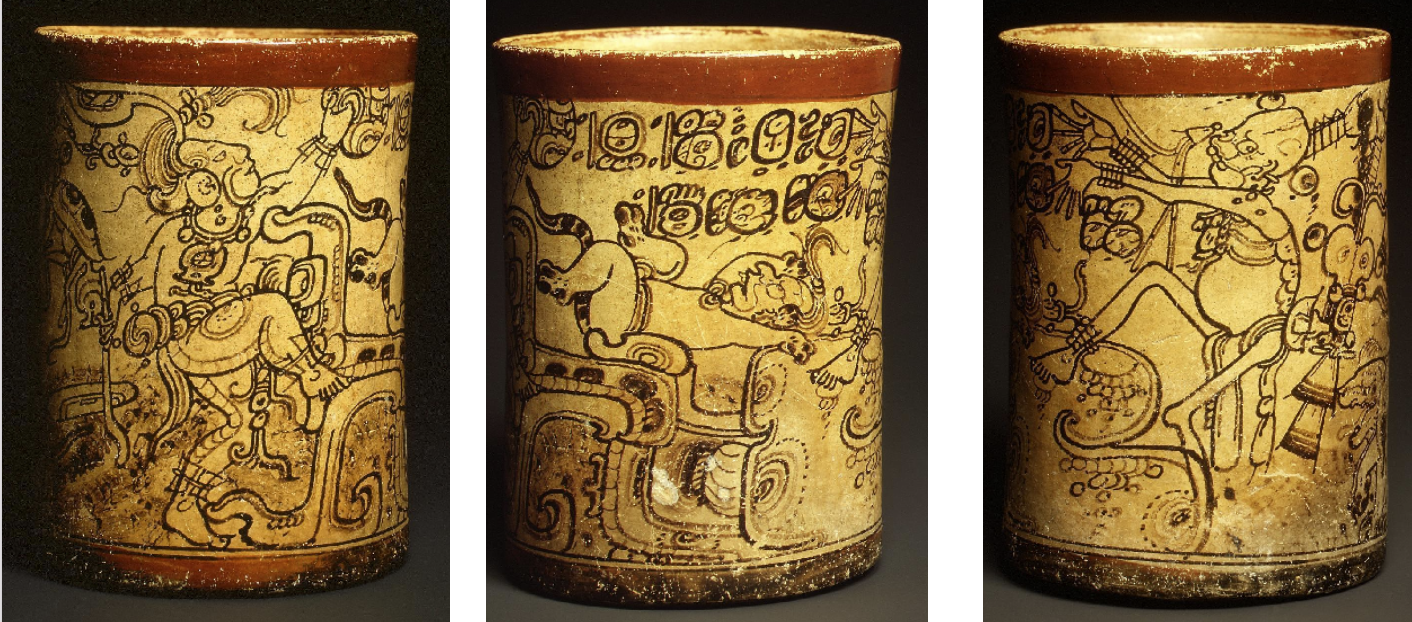
Room 1, Bonampak (Late Classic)

Room 2, Bonampak, Late Classic
East and south walls

Twin Pyramid Complex
The basic layout of a twin-pyramid complex consists of identical pyramids on the east and west sides of a small plaza, with a walled enclosure to the north housing a sculpted stela-altar pair and a range building to the south. Plain monuments were generally raised at the foot of the east pyramid.
lintel
a block across the top of a doorway
Puuc style, Río Bec style
Rio Bec style has large towers at the corners, rising at steep verticle angles, like very tall pyramids.
In Puuc style, The lower portion of the façades are blank with a flat surface of rectangular blocks punctuated by doorways, while the upper façade is richly decorated with intricate stone mosaics, often alternating repeated geometric elements with more elaborate figurative sculpture.
foursquare ritual enclosure
?
monster mouth
an entrance shaped like a monster mouth, perhaps resembling a cave or entrance to underworld?
popol na
the house of council
bicephalic dragon
This two headed dragon can be found on Pacal’s sarcophagus
wayob
cylinder vessel
codex-style painting
a painting made in the same style as/by the same artists who made codices
roofcomb
a structure that is atop a pyramid or roof
katun
a unit of time in the Maya calendar equal to 20 tuns or 7200 days, equivalent to 19.713 tropical years
drum-major headdress
girl idk
zoomorph
art imagining humans as animals/animals as human
u-bah
a key mayan glyph. u = his/hers/its. the glyph may refer to self, person, body, head
Man in a bird suit, Structure A, Cacaxtla (Terminal Classic)
Figure standing on feathered serpent, renewed interest in Quetzalcoatl
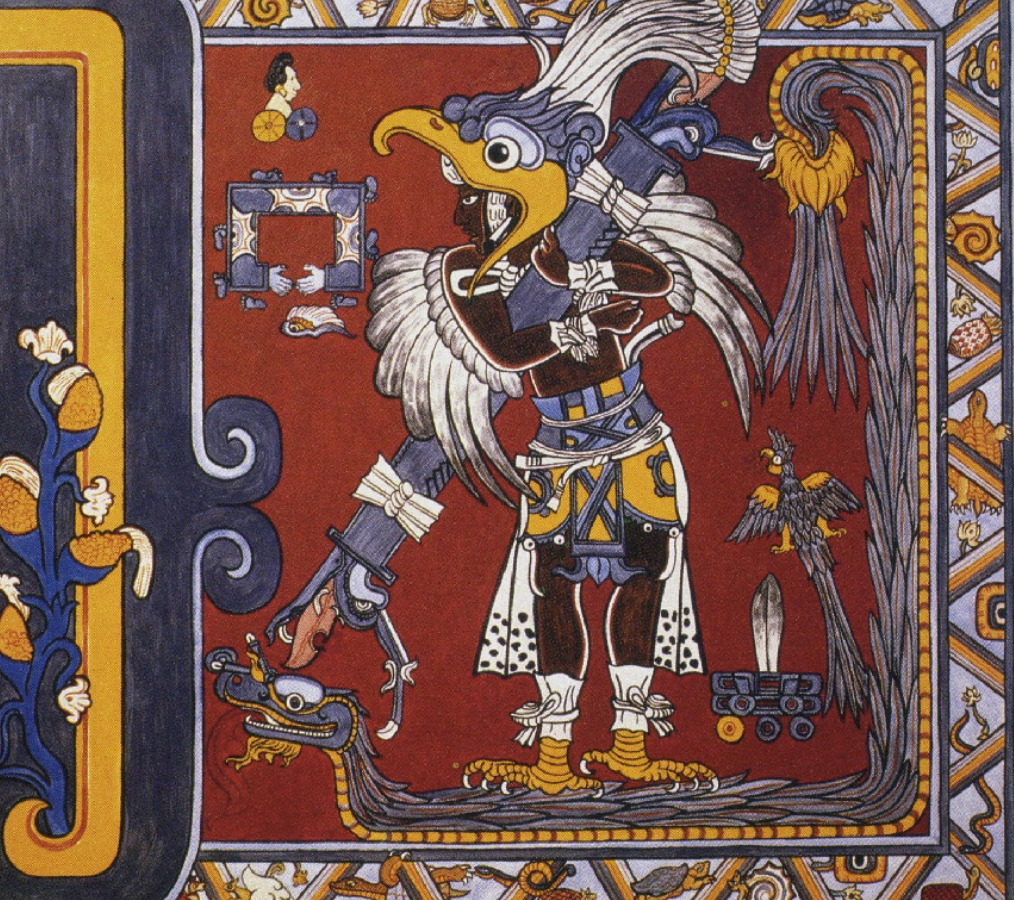
Pyramid of the Feathered Serpent, Xochicalco (Terminal Classic)
Very deteriorated in 19th century, very reconstructed now. Two stepped pyramid. Slightly unusual shape (second level slightly set back). Central Mexican and Mayan features. Figures on the top level in a clear pose of a seated figure (Mayan), seated lords like in Altar Q. The feathered serpent is a quetzalcoatl.
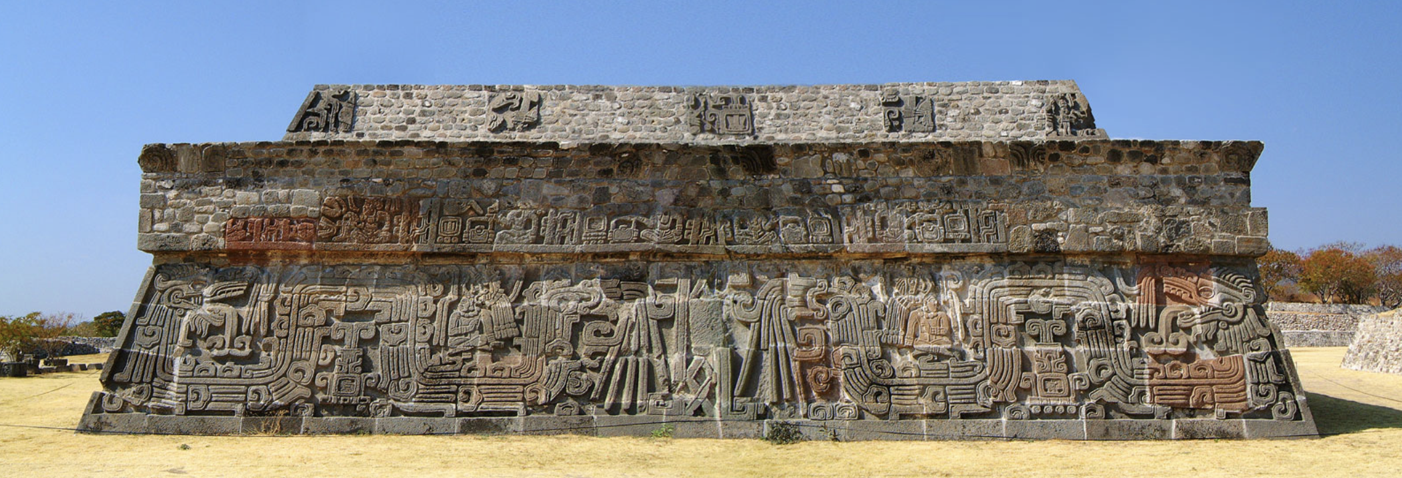
Pyramid B, Tula (Toltec, Early Postclassic) [pyramid and atlantean columns]
Different that Temple of the Feathered Serpent bc tablero-talud wasn’t used. Similar to it bc of tenon heads (eroded so we don’t know what they are)

Chacmool, Pyramid B, Tula (Early Postclassic)
Maybe derived from Mayans because of depictions of captives in similar pose (ruler seated on bicephalic throne of prisoners)
Place to put offerings on the chest
Almond eyes, helmet, fairly unclothed figure
New kind of feature, prominent in Tula
Not much in Tula bc Aztecs took them and brought them to Tenochtitlan
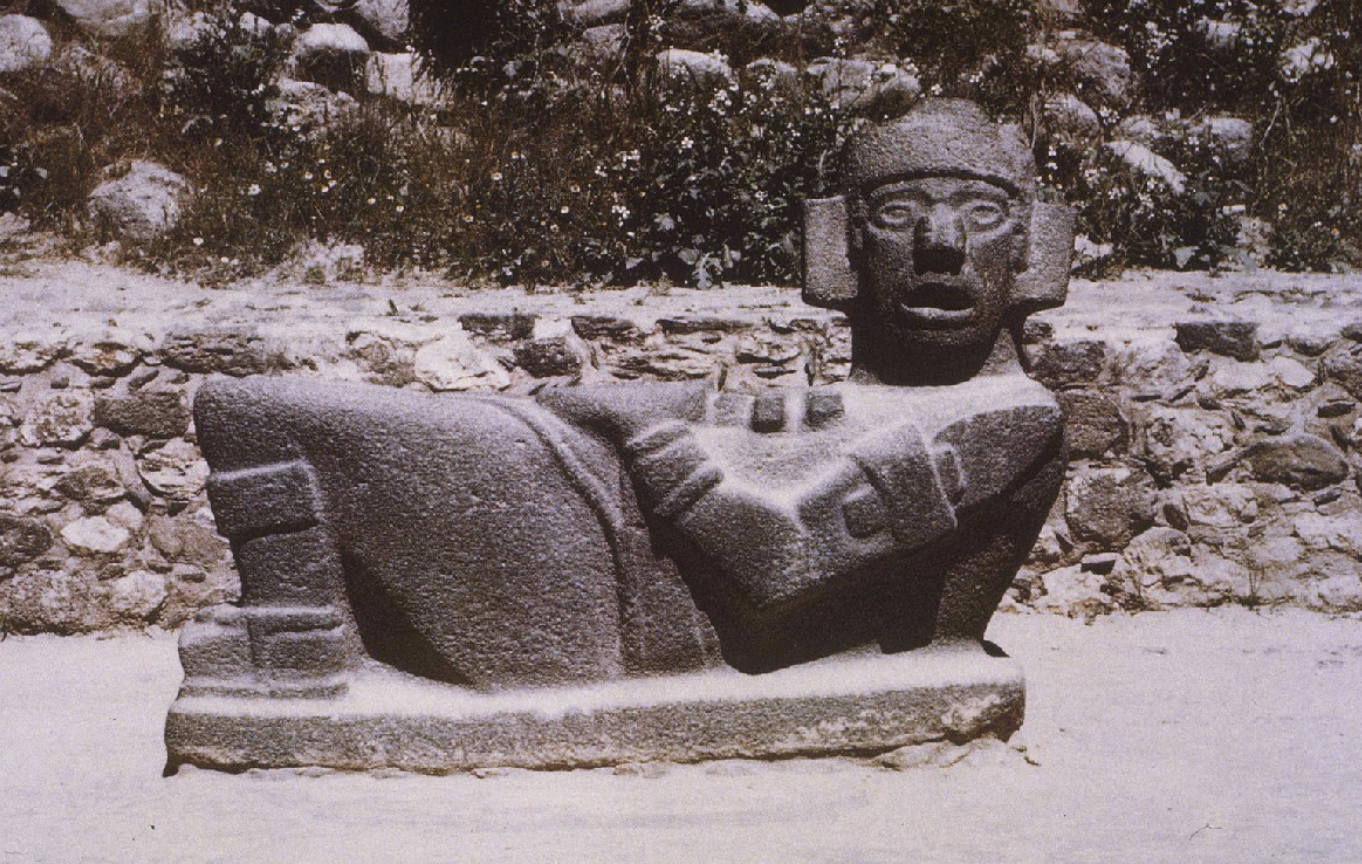
Castillo, Chichen Itzá (Early Postclassic)
Aligned with the movement of the Sun at parts of the year, serpent “magically” becomes visible when sun rises at certain times of the year
9 levels, also seen at Palenque (referencing levels of the underworld?)
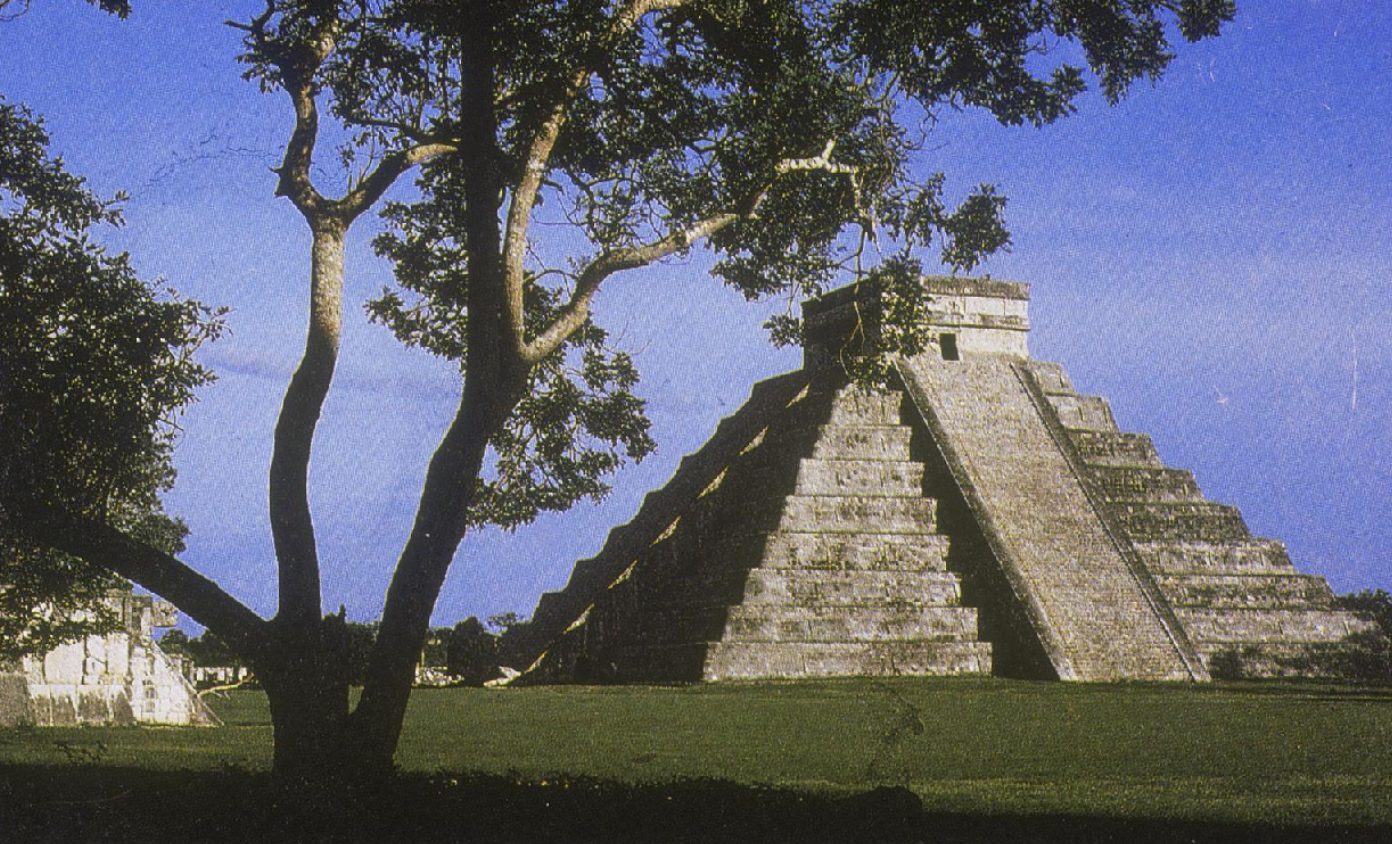
Chichen Itza
Structures are more scattered, like in Uxmal
Southern portion of site very Mayan
Columnated structure next to Temple of the Warriors
Tzompantli
Cenote (metalwork and human sacrifices found in there)
Temple of the Warriors, Chichen Itzá (Early Postclassic)
Similar to Tula Pyramid B
Theory: did Tula conquer Chichen Itza

Sacrifice of ballplayers, relief panel, Great Balcourt, Chichen Itzá (Early Postclassic)
Person beheaded, serpents erupting out of his neck
Yokes and palmas visible on players
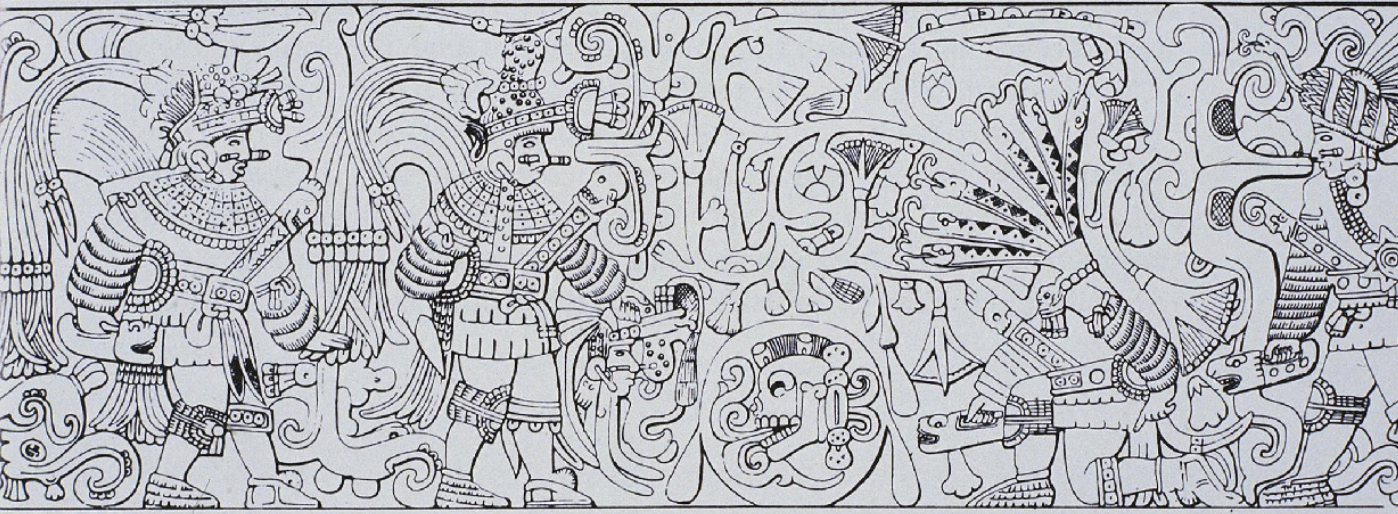
Conquest scene, Temple of the Warriors, Chichen Itzá (Early Postclassic)
As you move up, you move back in space
Leading prisoners (unclothed, bound)
Prisoners are “candy-striped” (later central Mexican/Aztec practice, maybe originated in Central Mexico)
Lots of different animals

Dresden Codex (Late Postclassic) [Pages 47 and 60]
Glyphic texts
4-5 codices from Postclassic in Central Mexico
Dresden Codex is the most well preserved
Tall pages
In Mayan region, codices are usually divinitory/astronomical almanacs
Usually made from the bark of a fig tree/treated animal skin
Accordion folded
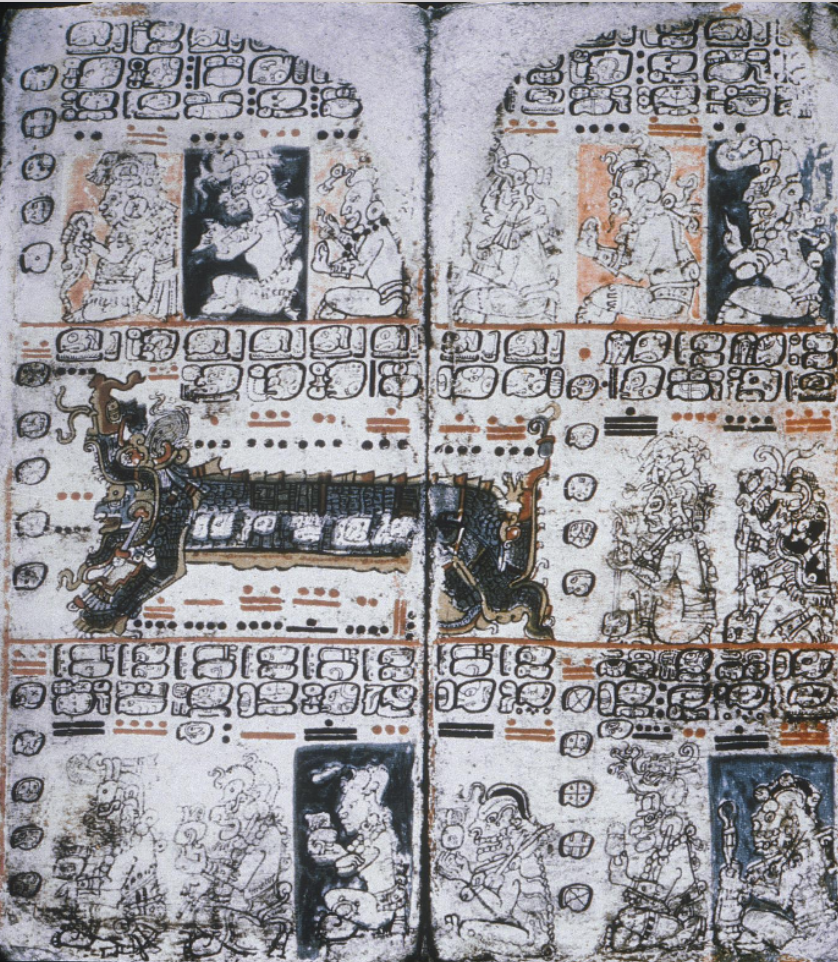
Quetzalcóatl
a feathered supernatural deity
coatepantli
a snake rack
tzompantli
a skull rack
cenote
a natural pit/sinkhole
Tezcatlipoca
a creator god, brother of quetzalcoatl
Tollan
a name used for the capital cities of two empires of Pre-Columbian Mesoamerica; first for Teotihuacan, and later for the Toltec capital, Tula, both in Mexico
chacmool
a form of pre-Columbian Mesoamerican sculpture depicting a reclining figure with its head facing 90 degrees from the front, supporting itself on its elbows and supporting a bowl or a disk upon its stomach.
plumbate ware
Looks like lead-based paint
Often used in vessels with bulbous lower form
Sometimes has legs
Seen often in Mayan regions + some others
Thought to have derived in the far southeast (Copan), highly debated
Shows interaction between different parts of Mesoamerica
repoussé
disk hammered on one side to create image on the other
atlantean column
Standing on top of pyramid
Depicts warriors
Male figures because they are costume
Pillbox hat, butterfly pectoral
pillbox headdress
?
Temple Mayor, Tenochtitlan (15th century) [excavated remains and reconstruction]
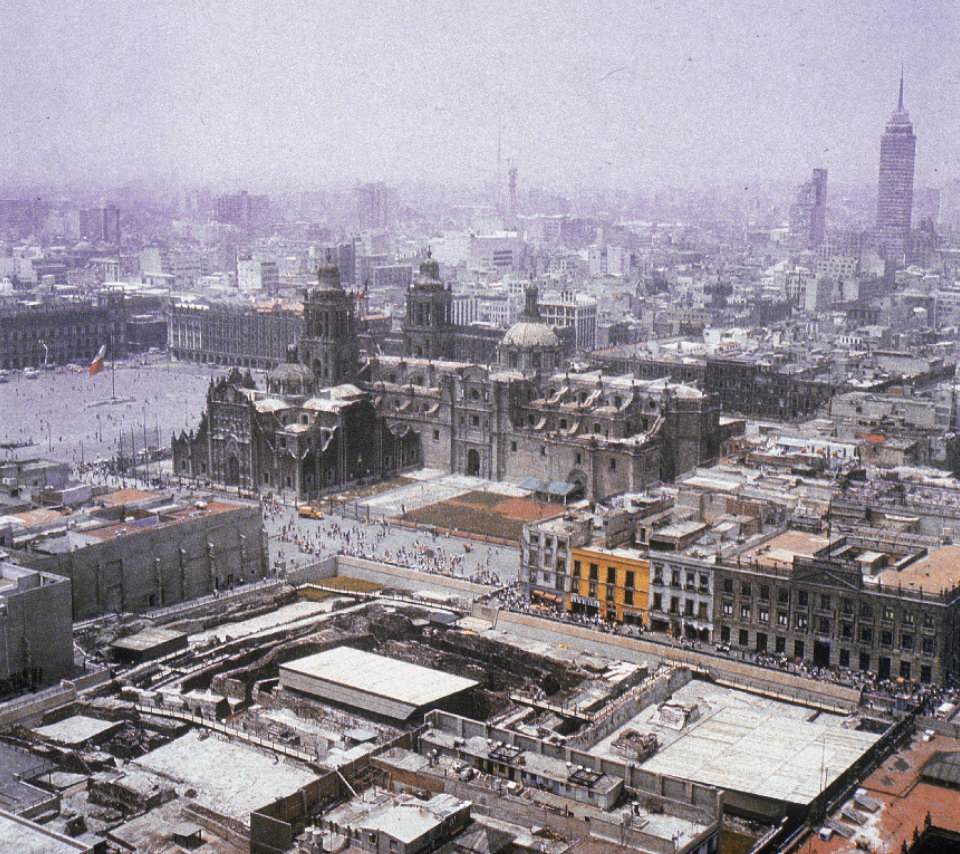
Statue of Coatlicue, Tenochtitlan (15th century)
Very well known
Wears skirt woven with serpents
One of the siblings to the Plague demons? Becomes pregnant with Huitzilopochtli. One of Coatlicue’s siblings doesn’t want the kid to be born so she decapitates her
Shows her head missing, serpent heads coming together function as a head
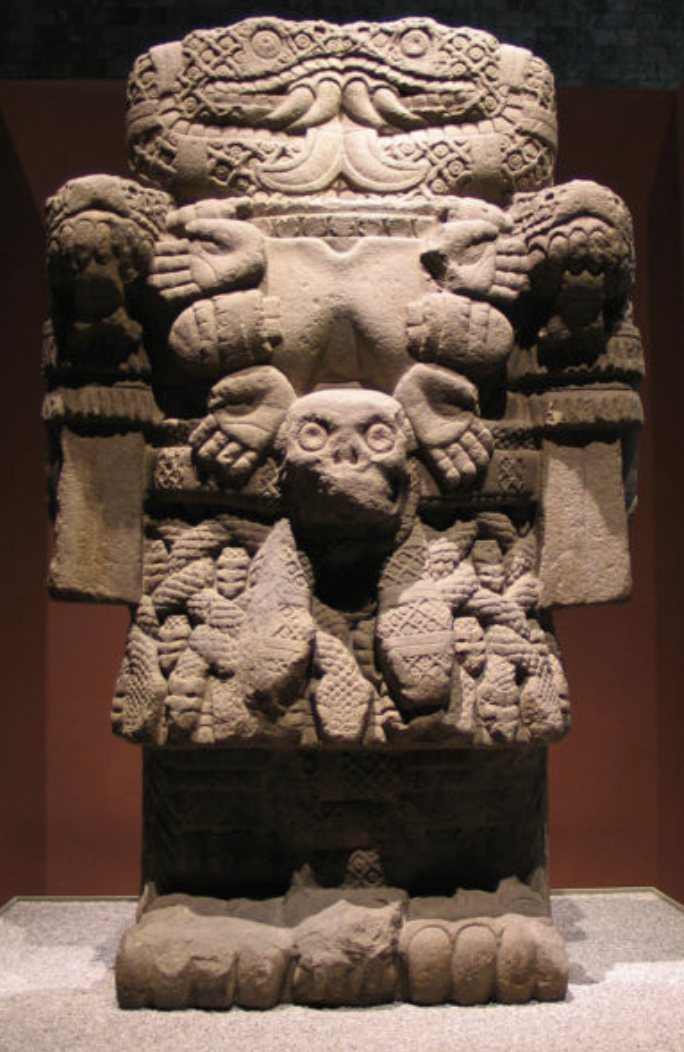
Coyolxauhqui stone, Tenochtitlan (15th century)
Dismembered form of Coyolxauhqui
Templo Mayor alludes to this and how it leads to the principal deities on top of it(?)
Pyramid on top is a version of the mountain that Coyolxauhqui’s body is at the base of(?)
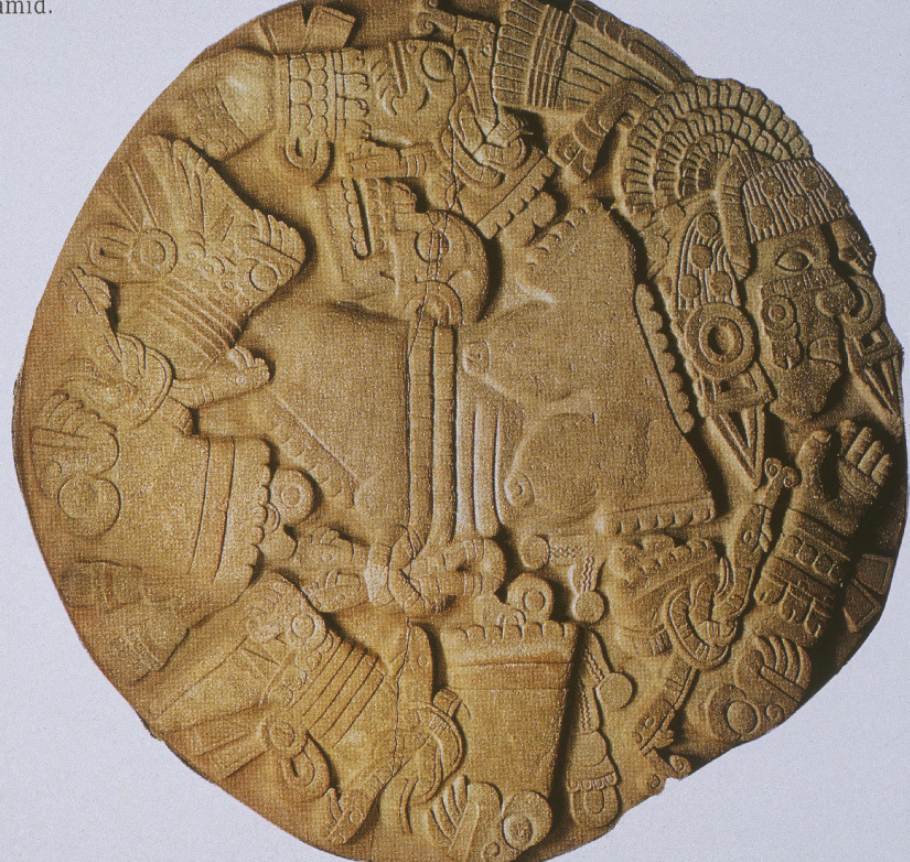
Stone of Tizoc, Tenochtitlan (15th century)
Eagle bowl, for offerings
Solar diadem on the top, allusion to the sky
Earth signs on the lower edge
Figures seen between earth and sky
What figures are doing separates earth and sky/prevents day of catastrophe? (taking of prisoners)
Used in a ritual connected with taking captives/human sacrifice
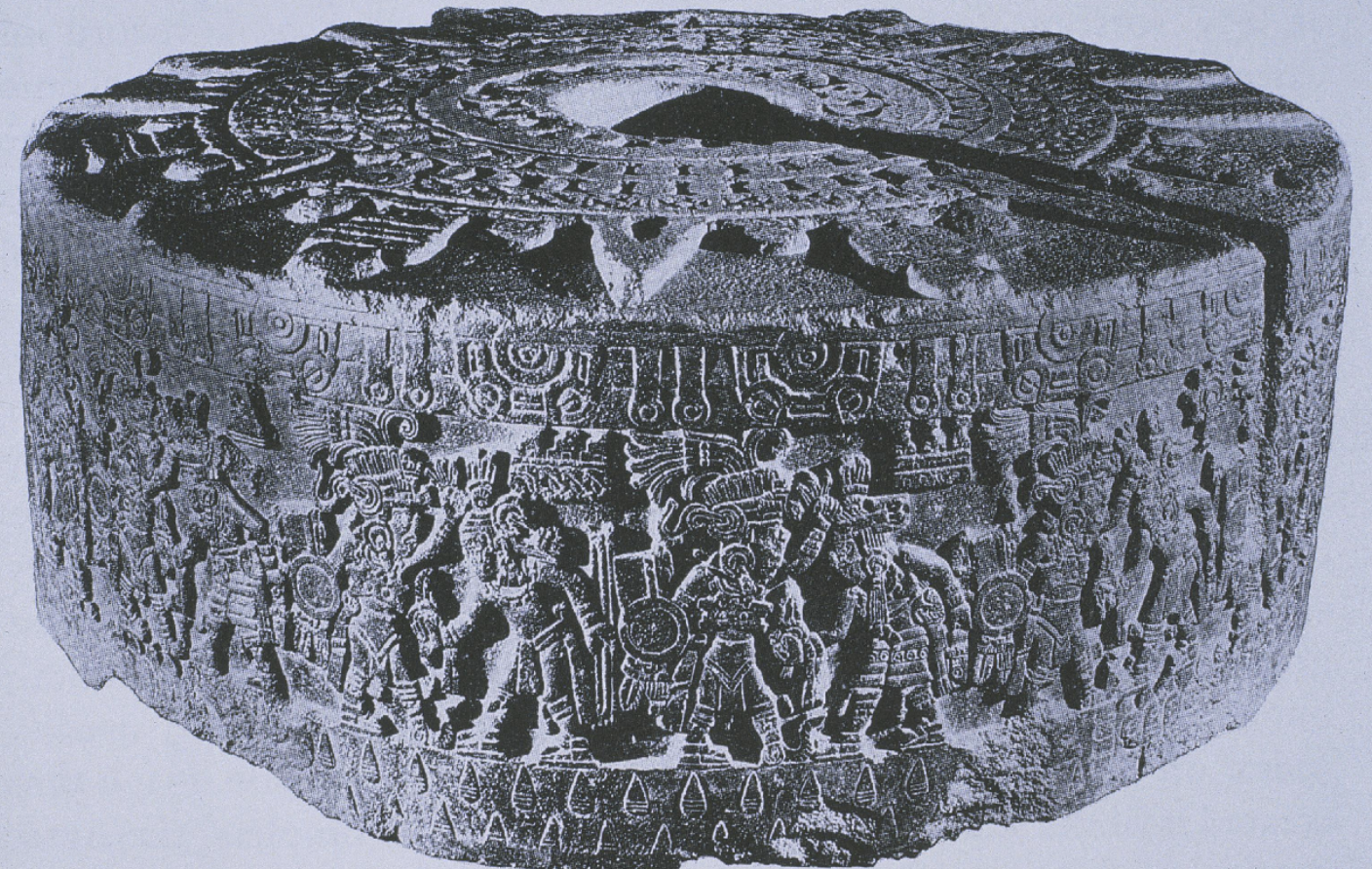
Calendar Stone, Tenochtitlan (15th century)
Very huge and well known
Would be laid flat on the ground, oriented to cardinal directions
Bicephalic serpent wrapped around it with human heads coming out of mouths, allusion to celestial realm?
Earth monster possibly shown in the middle, cataclysm by movement/earthquake (the shape that surrounds earth monster represents movement, around this is 20 day signs, includes another mini movement sign possibly predicting when the catastrophe will happen)
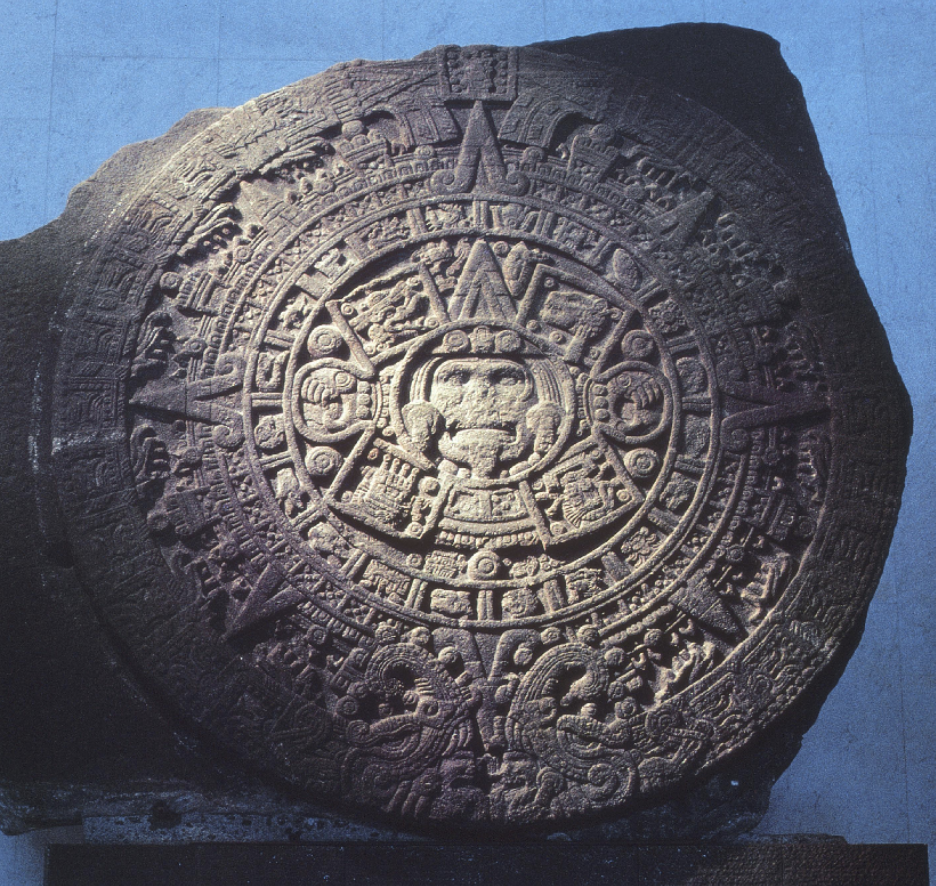
Xipe Totec impersonator, stone effigy figure (15th century)
Older Central Mexican deity connected to agricultural fertility/cycles of life and death
Impersonator wears flayed skin of a sacrifice
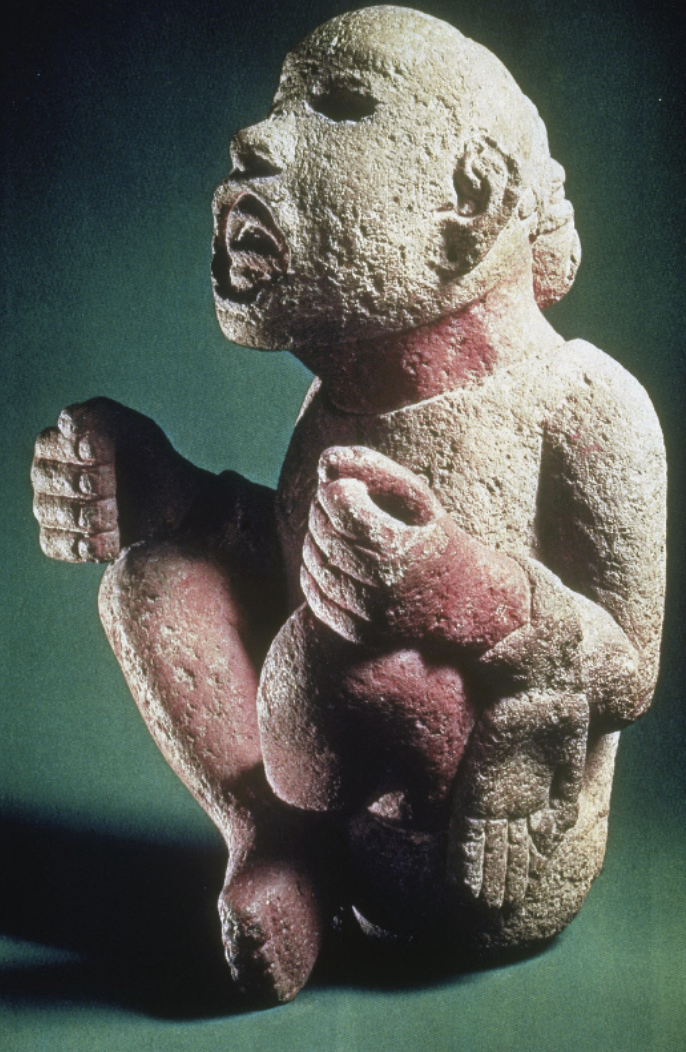
Chicmecoatl, ceramic effigy figure (15th century)
associated with fertility
Another “impersonator” (priest wearing costume of deity)
Ceramic assemblage, architectural

Huehuetl depicting Jaguar and Eagle Knights, Malinalco (15th century)
Codex Mendoza shield with seven dots seen here
Olin symbol (movement, in calendar it alludes to end of the world/warfare)
Priest-like figure dressed in eagle costume, human head coming out (unusual pose, sort of crab-like, holding head up)
Dancing in a circle
Drum creates noise to go along with dancing on it
circle=repeated/cyclical activity, similar to Stone of Tizoc
Fire and water = atltlachinolli
Mosaic mask of Tezcatlipoca (15th century)
“He of the smoking mirror”
Texcatlipoca like an Aztec K’awiil
Has snake leg and smoke coming out of mouth
Possible that mask was sent by Cortez to Charles the 5th
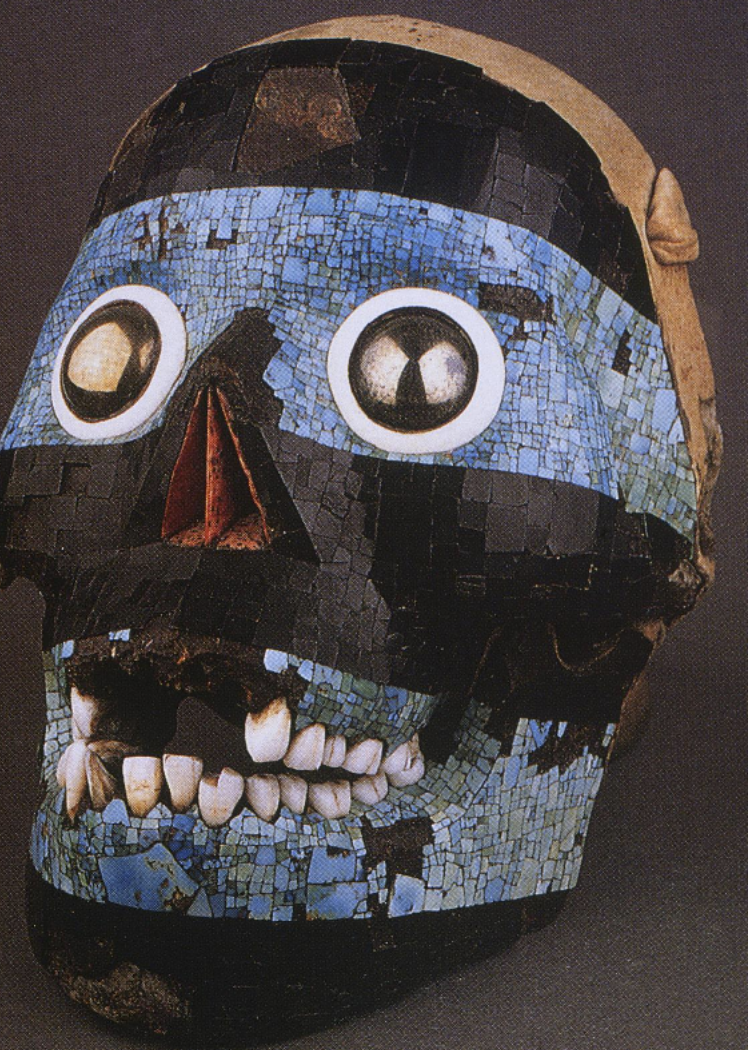
Frontispiece depicting Tenochtitlan, Codex Mendoza (mid-16th century)
Mendoza was a viceroy of Spain, employed native artists to make this
Altepetl shown in the bottom portion (shows that a community is there)
Top portion shows split of quadrants of Tenochtitlan
Quadrants like a quincunx, could be used to show the entire Aztec empire itself (could refer to larger or smaller scale)
Two ways of representation (pictographic and european/latin translation)
Surrounded by connected glyphs (51 day signs, almost full 52 year cycle, allusion to cyclical time, shows concern about the end of the cycle (cataclysm)
Name of city is given with eagle on a cactus and with the symbol/spears with seven dots (identity is tied with warfare)
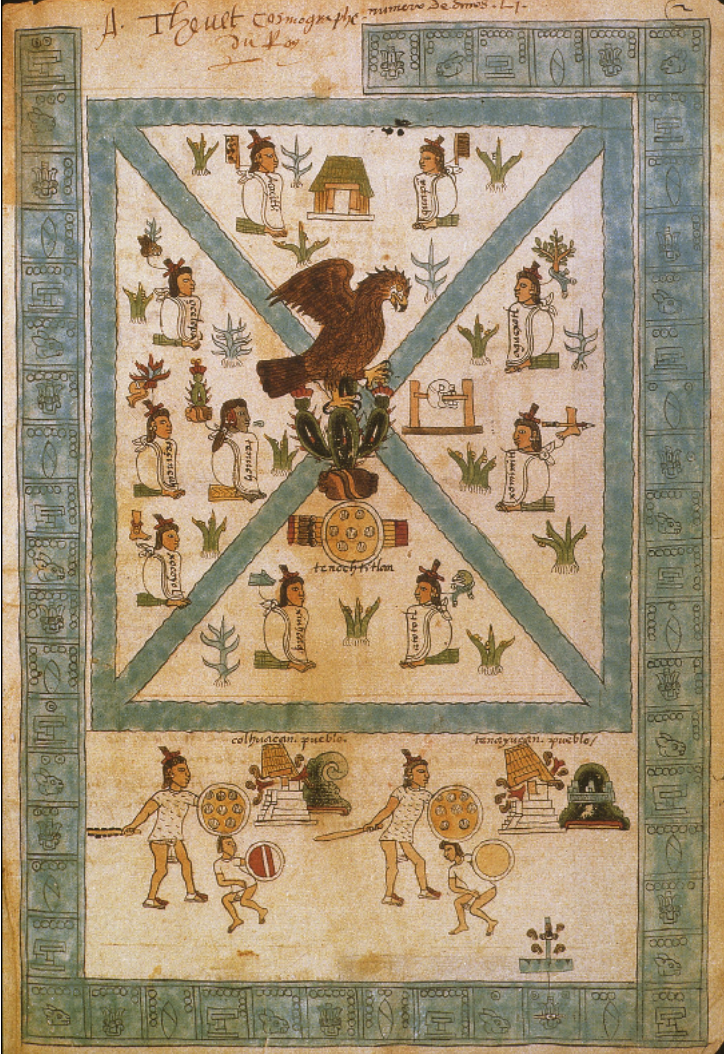
Story of 6 Monkey, Codex Selden (late 15th century)
Shows story of 6 Monkey
Each page depicts movement as a serpentine path (called boustrophedon, used to mean the directions you’d go while tilling ground on an ox)
Shows footprints
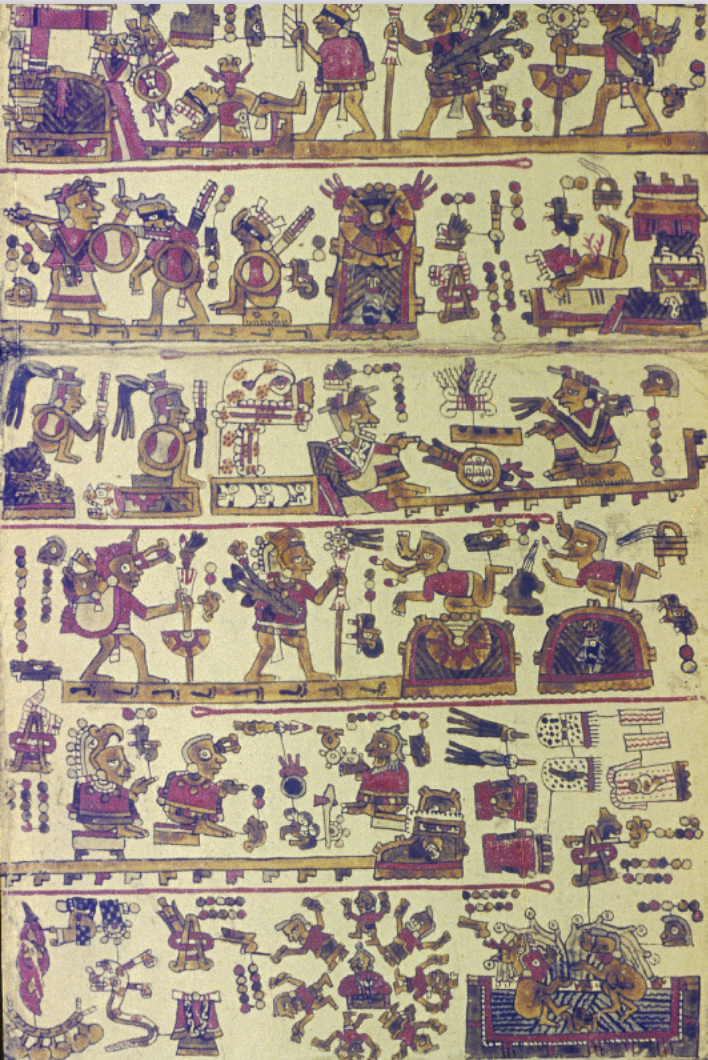
Mictelantecuhtli and Quetzalcoatl as Ehecatl, Codex Borgia (late 15th century)
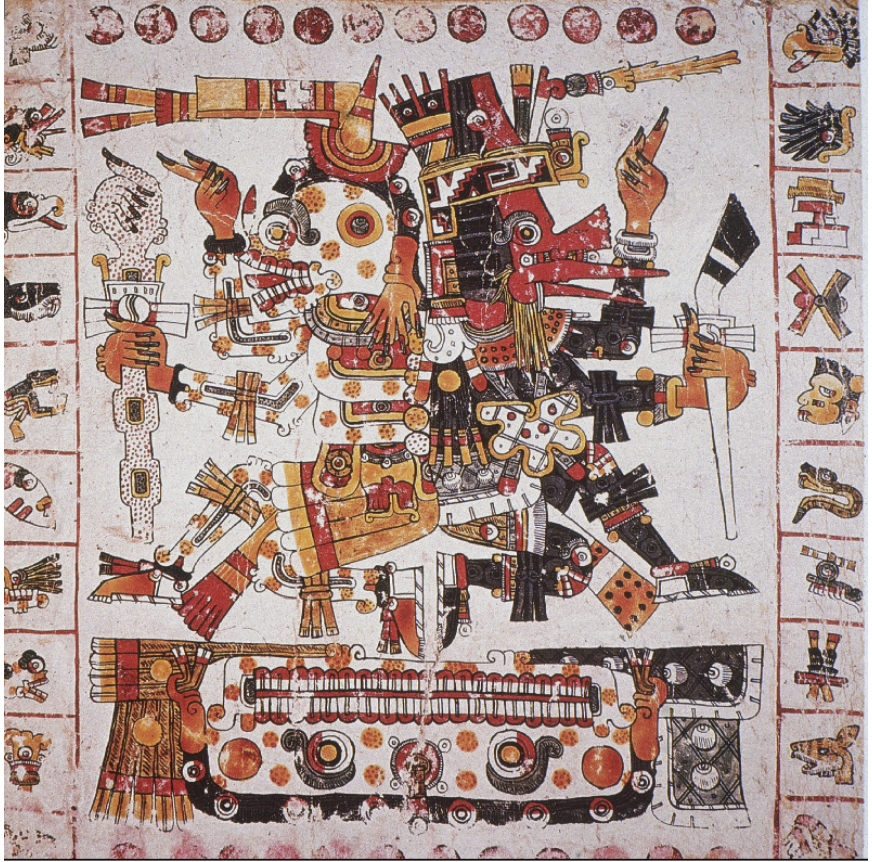
Xiuhtecuhtli depicted in a cosmogram, Codex Féjerváry-Mayer (late 15th century)
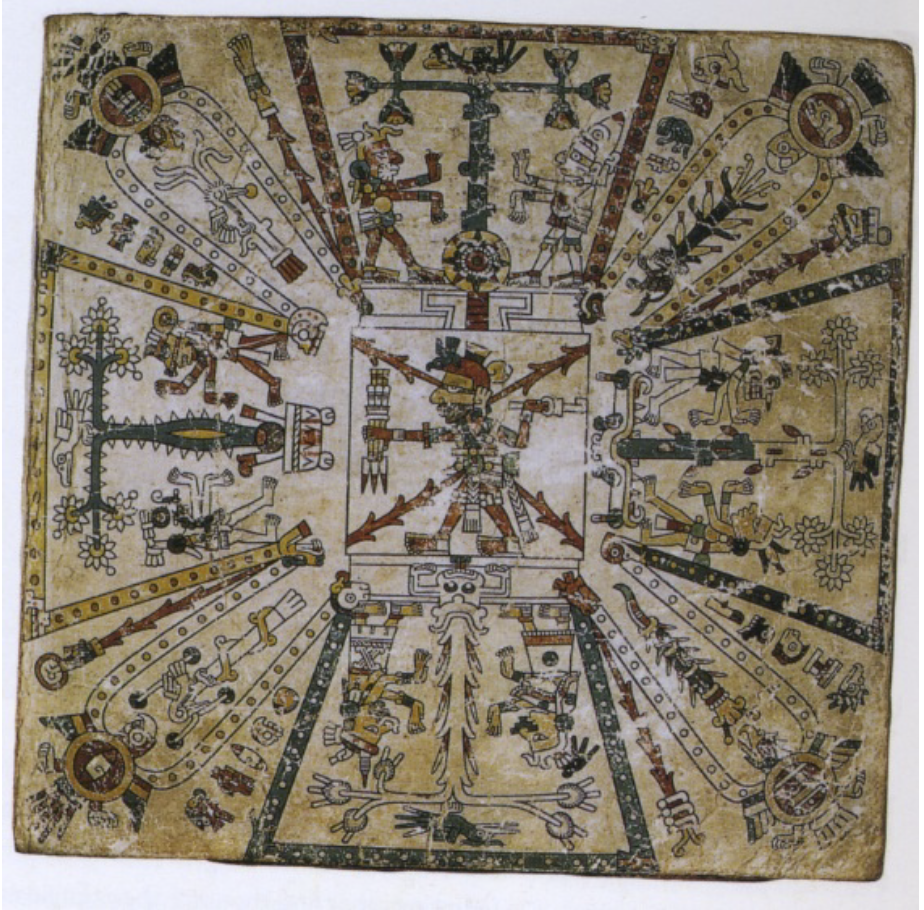
Huitzilopochtli
the Aztec sun and war god
Coyolxauhqui
a daughter of the goddess Cōātlīcue. Led her brothers in an attack against Coatlicue after they learned she was pregnant, and felt dishonored.
Jaguar/Eagle Knights
members of special elite military society in Aztec culture
quauhxicalli
an altar-like stone vessel used by the Aztec in sacrificial ceremonies, believed to be for holding human hearts.
Borgia/Mixtec groups
Groups of codices organized by their similar origin/design/context
teotl
something supernatural/out of the ordinary, an essence of divinity
flowery war
a ritual war fought intermittently between the Aztec Triple Alliance and its enemies on and off for many years in the vicinity and the regions around the ancient and vital city of Tenochtitlan
ollin
the day of the earthquakes
atltlachinolli
the symbol for war in the aztec/mexica language
mosaic mask
a mask decorated with tiles like a mosaic
Mictlan/Mictlantecuhtli
Mictlan is the Aztec underworld, mixtlantecuhtli is the god of the underworld
impersonator
an impersonator of a god/goddess was seen as an actual incarnation of the god/goddess
Coatlicue
The Aztec goddess who gave birth to the moon, stars, and Huītzilōpōchtli, the god of the sun and war.
Xipe Totec
God of Agriculture
huehuetl
a vertical drum
boustrophedon order
a style of writing that moves across the page (or pages) like a snake, back and forth zig zagging almost
teixiptla
the general description of impersonator statues, the world means impersonator or substitute for a god/goddess. can be a statue, a costume, or someone wearing a costume…
kenning
using a phrase to substitute a word, using something else as a stand in for something (ex. “Nice wheels” means car)
Virgin of Guadalupe, Basilica of Our Lady of Guadalupe, Mexico City (16th century)
spanish prepared the new land as an eden to prepare for the second coming of christ, converted vassal city leaders so they would then convert their constituents. the story of the virgin is that juan diego, a mestizo man, was told by the virgin to build a church, and his priest didn’t believe him so she sent him a miracle
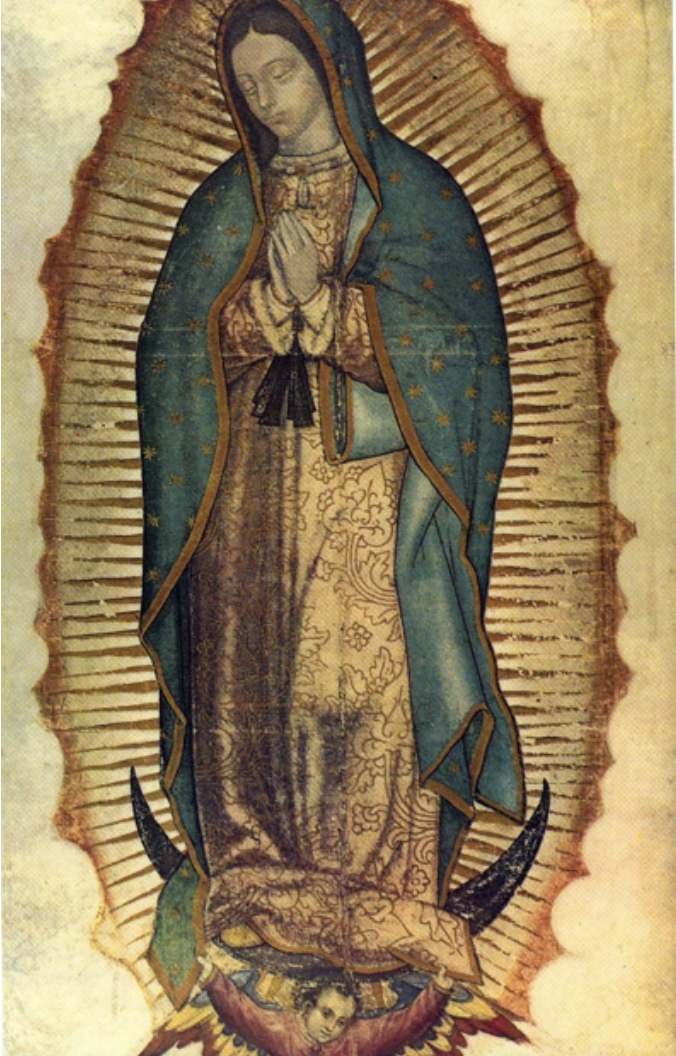
Open chapel, San Luis Obispo, Tlamanalco (1560)
hybrid art/architecture inspired by and can serve both colonizer and native needs. indoor outdoor. a mission church, kind of like a monastery with quarters

Posa chapel dedicated to St. John, San Andres, Calpan (1548)
posa chapels were smaller chapels in the corner of the courtyard. marked the 4 cardinal directions. circular relief sculptures above the entrance depicting the four gospels, each represented by an animal (mark = lion, matthew = man, john = eagle, luke = bull)

Mass of St. Gregory (ca. 1550)
European+Mexica way of depicting space

New Fire Ceremony, Codex Borbonicus (16th century)
depicts rituals and deities, illustrated books by native artists. footprints record procession. similar to codex borgia with the depiction of the ceremony and allusions to procession/ceremony
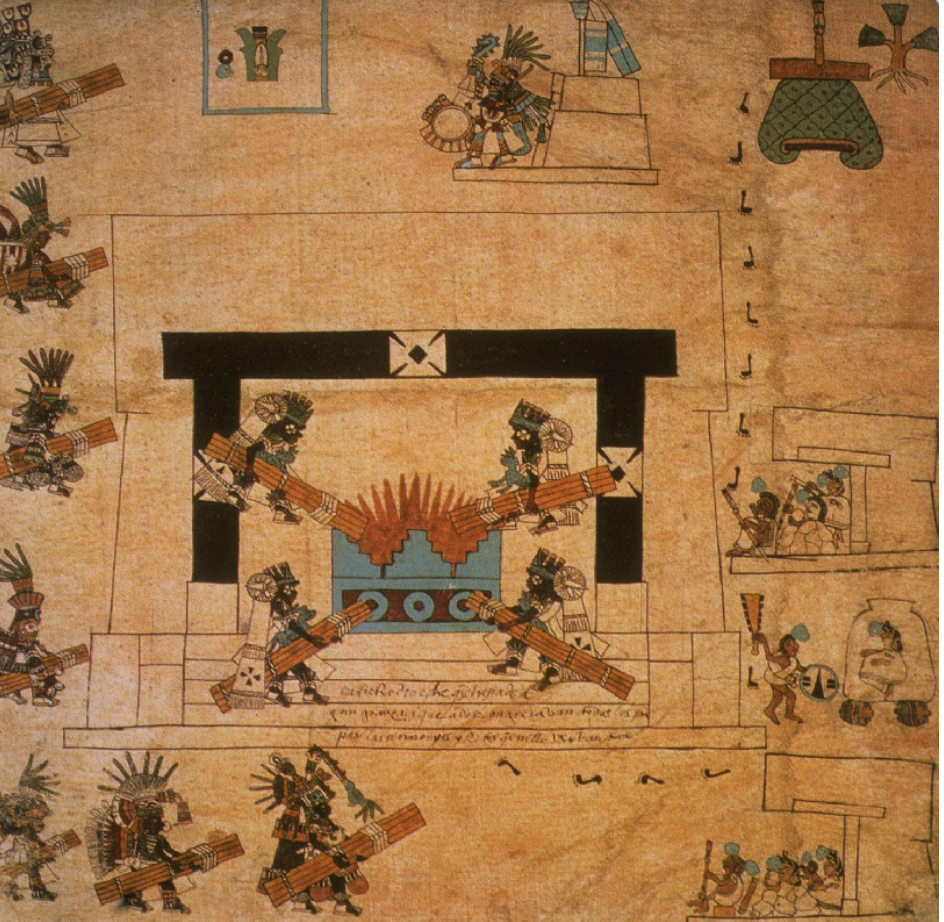
Mactricula de Tributos, tribute from Tepecoacuilco and Xoconochco (16th century)
depictions of everything sent as tribute/gift to someone/something/a place, sort of like an inventory?
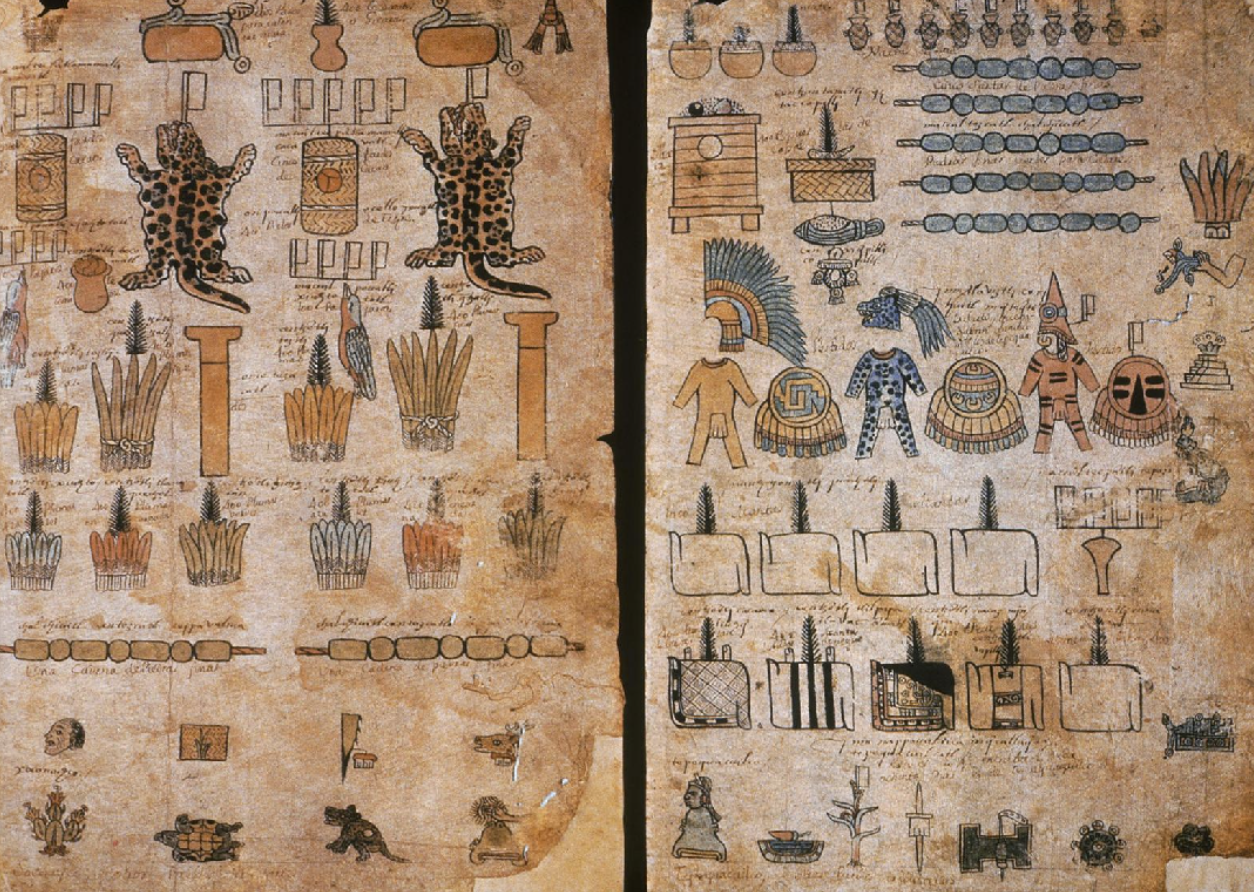
Carving the portrait of Motecuhzoma II at Chapultepec, in Diego Durán, History of the Indies (1579)
depicts the carving of moctezuma’s image into a large rock…Spanish understood this as a sort of Mt. Rushmore, depictions of rulers past and present in stone. chapultepec is an altepetl defined by a mountain with a grasshopper on top

Preparing feather goods, in Bernardino de Sahagún, History of the Things of New Spain (1547)
Sahagun would travel around
Interacted with converts who grew up during conversion, used them to talk to those who were alive during conquest
This piece depicts someone making feather crafts (a painting entirely made out of feathers, but looks like a painting!)
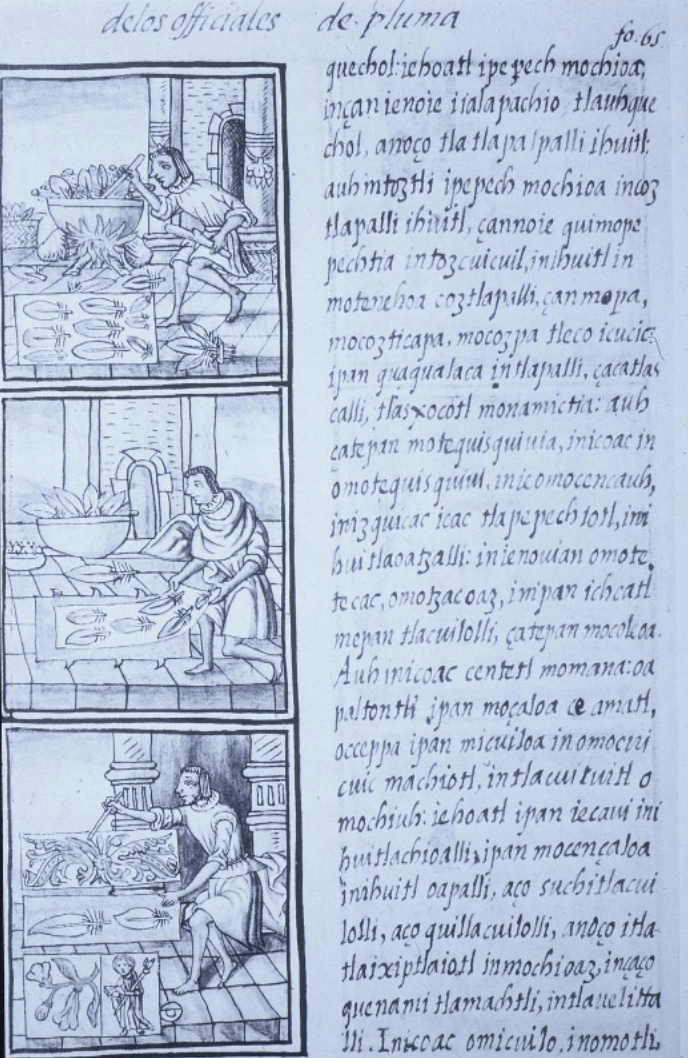
tequitqui
tribute (in context of tribute list, but recipient is now churches/religious authorities instead of native cities)
open-air chapel
a chapel that is/has a large courtyard where events take place in the open air
millenarianism
the doctrine of or belief in a future (and typically imminent) thousand-year age of blessedness, beginning with or culminating in the Second Coming of Christ
castas
the casta system designated social status based on proximity to whiteness/spanishness
Franciscans, Dominicans
the franciscans are one of the four remaining mendicant orders of the Catholic Church. They trace their founding to Saint Francis of Assisi in 1209. They are distinguished by their devotion to a simple life of near poverty and their focus on preaching to and serving the poor and marginalized in their communities.
the dominicans are known for their strong intellectual tradition, their role in preaching the Gospel, and their involvement in combating heresy, particularly through the Inquisition.